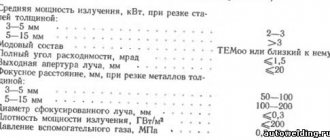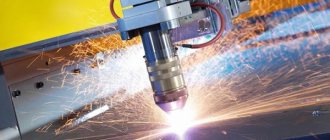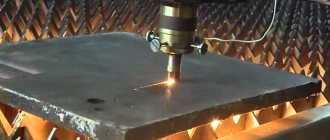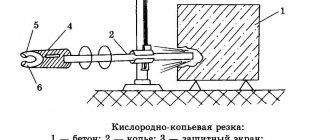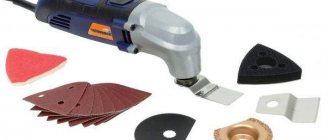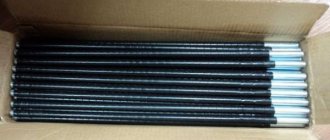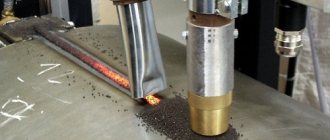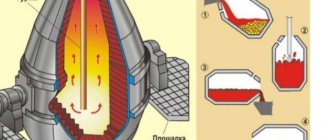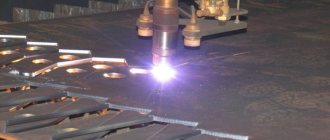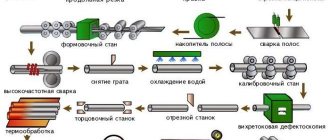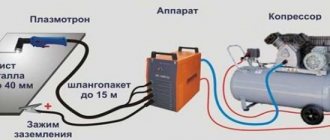Oxygen-flux separation cutting is a separation cutting method in which powdered flux material is introduced into the cutting area. Due to this, the amount of heat released during cutting increases and refractory oxides are deoxidized. As a result, it is possible to cut thick-walled rolled metal, castings, slabs, as well as concrete and reinforced concrete products.
Essence of the process
At the moment of formation of the oxygen stream, flux, most often iron powder, is slowly and continuously supplied. When burned, the powder releases the necessary additional amount of heat, thereby increasing the cutting temperature range. This method allows the formed oxides not to harden. Oxygen cutting using flux is used for:
- • high-alloy steels containing chromium and nickel, the components of which during the welding process form refractory oxides that are not eliminated by an oxygen jet;
- • work with cast iron and non-ferrous metals that are sensitive to temperature fluctuations.
Types of fluxes - iron and aluminum powders, quartz sand, silicocalcium and ferrosilicon - ceramic fluxes (for low-alloy steel), ferrophosphorus (for cast iron).
Gas for laser cutting of aluminum
When laser processing of metals, 4 types of auxiliary gases are used:
- oxygen, which is an active gas;
- nitrogen, classified as conditionally inert;
- argon and helium are truly inert;
- atmospheric air.
However, laser cutting of aluminum is performed using conditionally inert nitrogen, which participates in chemical reactions but is not an oxidizing agent. And when working with most metals, specialists try to prevent oxidation and combustion reactions.
In addition to the fact that nitrogen does not enter into oxidation reactions in the cut area, it displaces oxygen-containing atmospheric air from it. Thus, O2 also does not cause oxidation of the cut edges.
Oxygen when cutting aluminum with gas negatively affects the quality of processing, preventing you from obtaining clean and even cut edges. When cutting aluminum with O2, you can get uneven edges with many burrs. Some time ago it was used for cutting aluminum, since more powerful equipment did not exist. Then the uneven edges of the products were processed mechanically, improving their quality. However, additional mechanical processing increased the time spent on production and, accordingly, increased the cost of the finished product.
Currently, more powerful equipment is used; the use of nitrogen allows you to immediately obtain a high-quality cut that does not require further processing of the edges. This gas is suitable for cutting aluminum, stainless steel, high alloy steel, and nickel.
Types of oxygen-flux cutting
Oxygen-flux cutting technology processes metals with the pressure of a gas flame mixed with a stream of oxygen, which performs the function of a “cutting flame.” In this way, cutting durable metals can be done both manually and mechanically. For automatic oxygen-flux cutting, gas-cutting devices are used in which cutters are installed. Using the machines, the master can make surface cutting or separation. When cutting manually, special holders are used, in which gas and oxygen are also supplied under pressure. Both manual and machine methods can process high-strength metals up to two hundred millimeters thick at high speed (about 300-700 mm/min).
The essence of the gas cutting process
The process of cutting aluminum with gas involves heating the workpiece to a temperature of about +1,100 °C and then supplying an oxygen jet to the cutting zone. When gas interacts with heated metal, it ignites. A necessary condition for cutting is a constant and stable supply of a gas jet. In addition, the combustion temperature of the metal must be lower than the melting point. Otherwise, it will be difficult to remove particles from the work area that have melted but not burned.
VT-metall offers services:
Cutting aluminum with gas occurs as a result of combustion of the metal in a gaseous environment. The operation is performed using a cutter that supplies a mixture with the required proportions of gas (liquid fuel vapor) and oxygen masses. The cutter is also necessary to ignite the gas-air mixture and provide a separate supply of oxygen to the cutting area.
Gas cutting of aluminum is a high-performance thermal processing method that allows you to work with metals of any thickness. The daily output of a gas welder can be several tons of product. Experts include autonomy from electrical equipment as the advantages of this method of metal processing. This is important, since many works are carried out in conditions and at facilities where there are no power sources.
We recommend articles on metalworking
- Steel grades: classification and interpretation
- Aluminum grades and areas of their application
- Defects in metal products: causes and search methods
Using hand-held oxy-fuel equipment, you can cut a variety of metals. The exceptions are brass, stainless steel, copper and aluminum.
Devices for oxygen-flux processing of metals
Processing of metal products using the oxygen-flux method is carried out using special devices. The design of the device includes such elements as a cutter, a flux feeder, and a flux transmitter into the cutter. The metal-cutting tool in the device has a larger diameter compared to a similar device for cutting only with oxygen. Oxidizers, propane, nitrogen, flux-carrying gases, and CO2 act as combustible raw materials. The spear holder “KD-1” helps in the manual cutting process. Machine cutting with flux and oxygen is carried out on portal automatic devices and UKFR-6M installations. Devices for manual and automatic cutting process materials such as steel, cast iron, concrete, aluminum, and various non-ferrous alloys.
No less popular methods of cutting aluminum with plasma and laser
- Laser cutting.
This type of cutting requires a laser resonator that excites a narrow beam with a wavelength of the required length. The beam is directed to the designated cutting line and melts the metal of the workpiece due to the energy concentrated in it.
The advantages of cutting aluminum with a laser are:
- high performance;
- the ability to obtain parts of the required size and configuration without further modification;
- no deformation of cut edges;
- the ability to create products of various, including complex, configurations.
This method is used when it is necessary to make holes of complex shapes in workpieces, maintaining precise tolerances and fits. Due to the lack of contact with the metal being processed, it does not deform during the cutting process. The essence of the treatment is the transmission of pulsed laser radiation excited using a fiber, gas or carbon dioxide laser system.
- Plasma cutting.
To create a plasma flow, ionization of gas supplied under pressure by an electric arc is used. Ionized gas (hydrogen, nitrogen, argon) is heated to several thousand degrees Celsius. Aluminum and other metals are subjected to a short-term high-temperature effect; molten particles are removed from the cut zone instantly.
The advantages of plasma cutting of aluminum are:
- efficiency;
- ability to cut metals with a thickness of 200 millimeters or more;
- high performance;
- a wide range of processed metals and alloys;
- excellent quality of products;
- the possibility of producing products with complex configurations - both in mass production and according to individual drawings.
When cutting aluminum and other metals with gas, the choice of gas is made based on the thickness of the workpiece being cut: less than 20 mm - nitrogen is used, less than 100 mm - a mixture of nitrogen with hydrogen, more than 100 mm - a mixture of argon and hydrogen.
The process of oxygen-flux cutting of high-chromium steels
Products made of high-chromium and chromium-nickel steel cannot be treated with oxygen alone due to the fact that, when oxidized, chromium becomes refractory and is difficult to remove from the cut of the workpiece. For such materials, oxygen-flux cutting technology was invented. Steel blanks with a high chromium content are cut with a stream of oxygen to which powder (flux) has been added. The powder substance burns when it comes into contact with oxygen, the heat output increases, and the chromium steel begins to melt exactly at the cutting points. Working using this technology produces a clean cut surface.
Features and differences of technology
The possibility of oxygen-flux cutting of thick-walled metal (up to 1000 mm or more) is explained by the presence in the technological process of special fluxes, which, when interacting with cutting oxygen on the surface of contact with the material being processed, melt refractory oxides into slags with fluid properties. They are blown out of the cutting area with high-pressure oxygen. There is also minimal melting of the edges – i.e. there are no rough cuts.
Photo 1. Separating scrap cutting
Powdered fluxes are based on iron powder. During cutting, its particles burn after passing into the thickness of the metal, forming impact friction and removing refractory oxides from the edges of the product.
The main tool for oxygen-flux cutting is a cutter consisting of a spear holder and a pipe-shaped spear. Before operation, its end is heated to a temperature equal to ignition in oxygen. There is a valve on the handle of the cutting tool to turn on and regulate the oxygen supply.
Oxygen-flux cutting of cast iron
Cast iron products melt at very high temperatures, so the oxygen fluxing process is also used for cast iron. Oxygen cutting is not suitable due to the fact that cast iron contains silicon, which forms a durable film under the influence of CO2. You can melt it to get a neat cut on the product only with the addition of flux powder. Oxygen-flux cutting of cast iron prevents contamination of the oxygen stream and prevents oxidation from occurring at the cut sites.
Types of spear cutting
The method of oxygen-flux cutting of metal with the addition of flux powder is suitable for separation cutting of any metals, including high-chromium, stainless steels, copper, aluminum alloys, cast iron. This technology is even suitable for cutting concrete and reinforced concrete structures.
1. Cutting non-ferrous metals and alloys
Typically, this method cuts copper and brass, aluminum and its alloys - quite roughly due to the presence of an oxide film on the surface.
Burning flux produces a significant amount of heat - this compensates for the small thermal effect of burning copper-based alloys and minimizes heat transfer into the material being processed. However, it is important to consider that this also requires preheating the cutting area to approximately 200-400 °C.
If we compare it with cutting high-chromium steels, then when cutting copper there is an 8-12 times increase in flux consumption, and for brass – 4-8 times. For cutting, 2 types of fluxes are used:
1) a mixture of iron (50-55%), aluminum particles (20-40%) and sodium nitrate;
2) composition of iron (35-90%) and aluminum powder material (10-65%).
The edges of cut copper or brass parts are relatively rough, so they are usually further processed.
2. Cutting high-alloy steels
High-chromium steels (with a chromium content of 5% or more) are usually tempered at 300 °C before cutting. This is especially true for rolled metal, from which blanks of complex shapes will be cut. This will eliminate the possibility of cracks forming. Before cutting chromium-nickel metal grades, it is recommended to carry out a softening heat treatment.
Cutting must be carried out using dry fluxes; it is not recommended to use powders that have been stored in a flux feeder for a long time.
When using oxygen-flux cutting of high-alloy steels, it is better to hold the oxygen lance perpendicular to the material being processed and point it at an angle forward. This will allow you to get a fairly high-quality cut.
Various mixtures are used as flux materials - a composition of sodium bicarbonate (98-99%) and calcium phosphorus (1-2%), as well as dolomitized limestone, standard iron powder or quartz sand. All of the above mixtures, with the exception of the first, can also be used for cutting cast iron.
3. Cutting concrete and reinforced concrete
The spear cutting method is also applicable for concrete and reinforced concrete products. But since concrete does not burn in oxygen, to properly perform oxygen-flux cutting, powdered fluxes with increased thermal efficiency are required - for example, a mixture of iron (75-90%) and aluminum powder (10-25%).
Photo 4. Scheme of oxygen-flux cutting of concrete
The cutting technology is also different - the oxygen lance needs to be rotated from time to time during the process, and the movement must be performed in a reciprocating motion.
Oxygen-flux cutting of non-ferrous metals
The difficulty of processing non-ferrous metals (such as brass, bronze, copper alloys) is the high thermal conductivity of these materials. Oxygen does not generate enough heat to cope with non-ferrous metal parts. Cutting non-ferrous metals with oxygen and flux is done by adding a substance - ferrophosphorus - to the powder. In addition, the cutting process begins only after preheating to 300-400 degrees Celsius. When working with oxygen-flux technology, craftsmen wear respiratory masks, since the substances released during the process are harmful to humans.
Oxygen cutting technology
In the process of cutting rolled steel products, the material burns as a result of an exothermic reaction at a temperature below the melting threshold. This allows for high-quality separation of steel products, ensuring an even cut, absence of curvatures, roughness and slopes on the edge. In this case, slags are formed in the form of oxidation products, which, due to thermal effects, turn into a liquid state and are removed from the working area of the technical process by a stream of directed oxygen. If the oxides have a melting point higher than the melting threshold of the metal, cutting with oxygen equipment will become impossible. When exposed to the surface, oxygen must ensure a reaction with all layers of metal until complete, through burning. At the same time, the removal of slag is one of the main conditions, without which the lower layers of the alloy will not be accessible to the cutter. In this regard, oxygen cutting technology is used in its pure form for steels whose chemical composition implies a low degree of alloying. The permissible proportion of impurities can be up to 0.7% of the total mass.
In the case when the task is to cut rolled metal products made from special and high-alloy steel alloys using oxygen, special additives are used - fluxes. This situation is observed when cutting chromium alloys, the oxides of which reach a liquid state at a temperature of 2270 Cº at a melting point of the material of about 1900 Cº, as well as many other materials with additives in the form of carbon, nickel and other impurities.
Gases for plasma cutting of aluminum
High-quality cutting of non-ferrous metals is obtained as a result of plasma cutting. The plasma with which aluminum and its alloys are processed is formed through the use of inactive gases: hydrogen, argon or nitrogen.
Active gases, such as air and oxygen, are used to work with ferrous metals.
Cutting aluminum with gas using a plasma cutter is possible with a workpiece thickness of no more than 70 mm.
Gas mixtures containing nitrogen and argon are not suitable for working with aluminum, since they are intended for processing high-alloy steels 50 mm thick.
